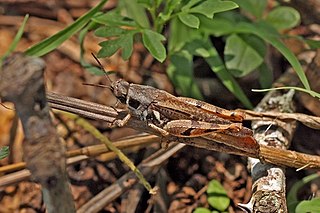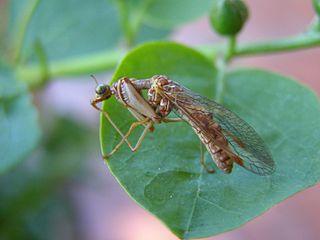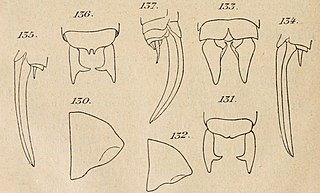Empusa or Empousa is a shape-shifting female being in Greek mythology, said to possess a single leg of copper, commanded by Hecate, whose precise nature is obscure. In Late Antiquity, the empousai have been described as a category of phantoms or spectres, equated with the lamiai and mormolykeia, thought to seduce and feed on young men.
Johann Karl Wilhelm Illiger was a German entomologist and zoologist.

Johann Centurius Hoffmann Graf von Hoffmannsegg was a German botanist, entomologist and ornithologist. The standard author abbreviation Hoffmanns. is used to indicate this person as the author when citing a botanical name.

Empusidae is a family of plant-mimicking mantises, consisting of 10 genera, in two subfamilies. Unlike many other mantis families, the Empusidae are a monophyletic lineage. Empusidae mantises are ambush predators, with mouthparts adapted to feeding on other insects and small animals. The majority of Empusidae species are distributed throughout Africa, but they are also found in Southeast Asia and in the southern parts of Europe.
Johann Gottlieb Kugelann was a German entomologist. A pharmacist by profession, Kugelann worked on Coleoptera.

Schistocerca is a genus of grasshoppers, commonly called bird grasshoppers, many of which swarm as locusts. The best known species is probably the desert locust and trans-Atlantic flight may explain the biogeography of some locust species.

Onthophagus is a genus of dung beetles in the Onthophagini tribe of the wider scarab beetle family, Scarabaeidae. It is the most species-rich and widespread genus in the subfamily Scarabaeinae, with a global distribution.

Melandryidae is a family of beetles in the superfamily Tenebrionoidea. Members of the family are found worldwide, with around 420 species in 60 genera. Larvae and adults are generally associated with rotting wood and wood-decomposing fungi.

Acrida is a genus of grasshoppers in the family Acrididae. The genus contains around 40 species which are found in Africa, Europe, Asia, North America, Hawaii, and Australia. Insects of this genus are omnivorous and a well-known pest of many agricultural crops.

Rhamphini is a weevil tribe in the subfamily Curculioninae.

Acrotylus is a genus of grasshopper in the family Acrididae and the type genus of the tribe Acrotylini.

Catantops is a genus of grasshoppers in the tribe Catantopini and is typical of the subfamily Catantopinae. Species can be found in Africa, including Madagascar and subcontinental India.

Oxya is a genus of grasshoppers found in Africa and Asia.

Oedaleus is a genus of grasshoppers in the family Acrididae.

Truxalis is a genus of grasshoppers in the family Acrididae, subfamily Acridinae and tribe Truxalini. Species can be found in: Africa, the Iberian peninsula, Asia minor through to Indo-China.

Mantispa is the type genus of insects in the family Mantispidae and subfamily Mantispinae. Species have a fairly worldwide distribution.

Conocephalus conocephalus is the type species of the conehead genus Conocephalus and the bush cricket tribe Conocephalini. This species has been recorded from southern Europe, including France, and Africa. Described by Carl von Linné in 1767, C. conocephalus appears to have no surviving type specimens, although it is believed that material may have been obtained from Africa.














